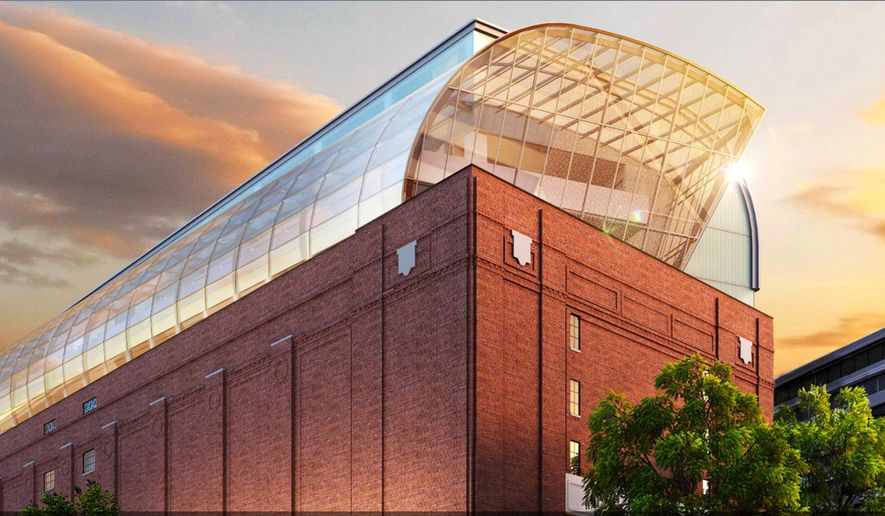The Museum of the Bible opens Friday just south of the U.S. Capitol, full of ancient artifacts, preserved texts and state-of-the-art technology, but very little Jesus.
Organizers said they designed the 3,100-object museum for people of any faith tradition or none at all, keeping exhibits light on evangelism and heavy on education.
“We’re nonsectarian, which means that we want to be a comfortable place for anybody — faith, no faith, we don’t care who it is,” museum President Cary Summers said Wednesday at the facility. “Come in and enjoy and walk away and say, ‘I learned something about the Bible while I was here.’”
The three major exhibits — on the stories, history and impact of the Bible — employ impressive audiovisual effects to immerse museum visitors in the worlds of the Old and New Testaments.
In one of the most striking exhibitions, titled “The Hebrew Bible,” visitors spend about 30 minutes walking through biblical scenes and stories beginning with the creation account in Genesis and ending with the rise and fall of the kingdom of Israel.
Some of the stories are told through animations projected onto a wall or screen, where visitors sit down for a few minutes before moving on to another room and another story.
Other scenes are depicted more abstractly, such as the account of God’s promise after the Great Flood, where visitors walk through an otherwise plain room lit up with rainbow-colored lights. In the telling of God’s promise to Abraham — that his descendants will be as numerous as the stars — the room goes dark and stars light up the ceiling and walls.
The museum’s more traditional exhibits include object-intensive galleries that recount how the Bible was compiled and translated.
William Lazenby, director of research with the museum design firm PRD Group, which helped design the exhibitions on the Bible’s history, said his goal was to “tell the biography of the Bible.”
“We look at it through the lenses of time, technology and culture, trying to tell the story of the Bible from something that was initially accessible to very few people in just a single language, to what’s grown into something that is near-universally accessible in hundreds and even thousands of languages,” Mr. Lazenby said.
Some of the museum’s most impressive objects include Dead Sea Scrolls fragments that date to the middle of the first century B.C. Also on display is Julia Ward Howe’s original draft of “The Battle Hymn of the Republic,” which contains biblical language and is included to demonstrate the Bible’s influence on American history.
Ancient artifacts aside, there is nothing old-fashioned about the Museum of the Bible.
The museum includes 12 theaters, a virtual reality exhibit set to open in the spring, and a digital flyover of the District of Columbia that takes visitors to sites around the city that contain allusions to the Bible, such as the Washington Monument.
Other attractions include a restaurant that serves food inspired by the Bible, a rooftop garden with plants indigenous to Israel and a 475-seat performing arts center, where the Broadway play “Amazing Grace” is running through the end of the year.
The building, originally a refrigeration plant built in 1922, is worth inspecting as closely as the artifacts it houses.
David B. Greenbaum, vice president of SmithGroupJJR and lead architect of the museum, said the 430,000-square-foot building is filled with biblical allusions.
“We’re always trying to see how we can develop a museum and a visitor environment and attraction to make it more memorable to people,” Mr. Greenbaum said. “And here the museum has done some unique things to do that.”
He said the building’s most striking architectural feature — the glass and metal atrium enveloping the rooftop — is shaped to bring to mind the biblical image of a boat or ark sailing on the D.C. skyline.
What’s more, the museum’s front entrance is bracketed by two 40-foot bronze replicas of Gutenberg printing plates, inscribed in Latin with Genesis 1.
“You’re literally walking into the Bible as you walk into the museum,” Mr. Burton said.
The $500 million project was paid for with private contributions — most notably from the Green family, of the Hobby Lobby arts-and-crafts fortune. Admission is free.
• Bradford Richardson can be reached at brichardson@washingtontimes.com.




Please read our comment policy before commenting.